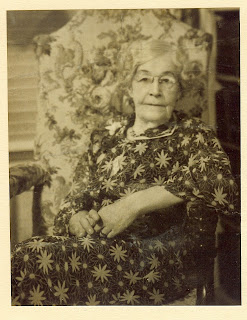“The years of the Depression were upon us, though I really wasn’t aware of it, at the time. My Father lost his job as a Supervisor with the Internal Revenue Service when the Roosevelt Regime came into Presidential office, and since my parents didn’t have any other income, I was sent to live with my Grandmother, Mary Jane McGinnis and my Great Aunt ‘Aunt Lyle,’ Elizabeth Gaffney, and my ‘Uncle Gene,’ Francis Eugene McGinnis (my Mother’s brother). Grandma had a small pension from the city, so we were sure of enough to eat.
“Grandma and Aunt Lyle were the dearest, most loving people I have ever met in my lifetime. My life was full of their Irish humor, blarney, and love, even complete with little Irish ditties:
‘Saint Patrick was born at four in the morning,
His Mither and Fither were there at the time.’
“My earliest memories with Grandma and Aunt Lyle were of so much love. They were wonderful to me. What can I tell you about Aunt Lyle? She was always smiling (I heard that she had quite a taste for liquor). But, though I guess I have to be truthful and say she was fat, she had the softest lap in the world. I’ve been told that I was her favorite. (Lucky me.) Another early memory was the beautiful little coat she made for me. It was a light salmon pink velvet, trimmed in ermine balls. Aunt Lyle had been a Milliner, and was famous for the beautiful hats she made. I understand she used to design a special baby bonnet for the babies in the Henry Ford family. I never saw a million dollars, but I did have a lot of those bonnets, too, along with many hand-smocked little baby dresses that the Fords didn’t have.
 |
My mother, Joan Schiavon (far left), with her cousins, Benita Jane “Janie” and Phillip “Bud” McCormick,
about 1931, Chicago, Illinois |
I guess that Grandma McGinnis was the example of what I always had hoped I would be like. Grandpa [Thomas Eugene] McGinnis died a year before I was born, but always it seemed to me that Grandma had lived just for him, loving him completely. (I, too, have been blessed with the dearest Husband ever, so it seems my prayers had been answered in that respect.) Grandma had the bluest eyes. How well I remember them, they were always full of love. Two days a week were ‘baking days,’ and Grandma would produce all kinds of delicious pies, cakes, and bread.
 |
Elizabeth Gaffney (1862 – 1934)
The back of this photograph reads “Pin-Lock
Medal, Chicago” and is dated
May 31, 1898. |
There was always extra dough, most of the extra would be made into ‘little pies,’ little triangles with either cinnamon and sugar inside, or ‘leftover’ apple slices from the bigger pies. The ‘little pies’ were just for me. I can remember sitting at the kitchen table for hours, my nose barely reaching the top, rolling a little ball of dough (sort of smudged looking, ’cause my hands weren’t always as clean as they should have been), and when Grandma would turn her back, I’d pop the whole thing into my mouth.
Our house was always full of delicious aromas of baked goods, and some of this must have wafted out of doors, as there always seemed to be a stream of people at our back door, especially when Grandma had been baking. People were desperately hungry, and they seemed to know that there would always be something for them at Grandma’s. I didn’t mind all the people who came around, as to this day, I love to have company. I do remember one ‘visitor’ especially. A gentleman, who seemed quite poor, but was different from all the others, as he came around to sell things such as aprons, pins, needles, pot holders, etc. Grandma always asked him in, sat him down for a cup of coffee and a piece of pie, and as many times as she could, would buy something. In later years, this same man, whose name was Morris B. Sachs, became quite wealthy, owned a large department store in Chicago, and finally, became the Treasurer of the City of Chicago.
 |
Elizabeth “Lyle” Gaffney’s millinery shop, early 1900s,
either Conneaut or Cleveland, Ohio. She also made
hats for Annie Sullivan, Helen Keller’s teacher and
was the chief milliner for Marshall Fields
Department Store in Chicago. |
“Sleeping with Grandma would be the happy time of the day for me. Grandma wouldn’t let me get up as early as she, so I would lie there under her big quilted comforter, and play imaginary games on the stitching on the comforter, imagining that I was traveling roads to heaven knows where.
“Those were days of imagination, and our toys were mainly very small things, for no one could afford to buy much in the way of toys. I would play for hours with local politicians’ business cards, standing them up along the window sill, and pretending that I was their teacher, and they my pupils. . . . Memories such as these seem to live on with one through their lifetime.”
– Joan Huesca
Copyright (C) 2012 Linda Huesca Tully
Did you know any of the people mentioned in this story, or are you a member of the Schiavon/Schiavone, McGinnis, Gaffney, McCormick, Olson, or Huesca families? If so, share your memories and comments below.




What a great first-hand remembrance of the Depression from someone you care so much about.
I found it interesting that, unlike many Depression families who sent their children out of the cities and into the country in hopes they'd have better chances of obtaining sufficient food, your mom ended up going into the city!